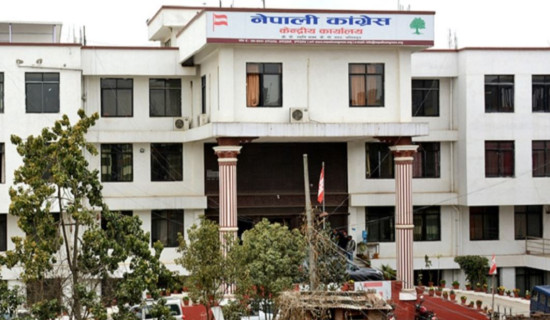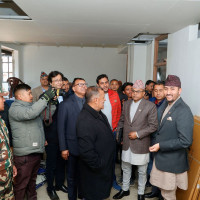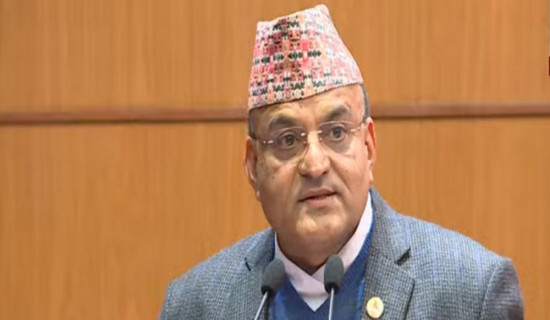- Tuesday, 23 December 2025
Unrestrained urbanisation poses risk of land subsidence in Kathmandu
BY SUSHMA MAHARJAN,Kathmandu, Aug. 18: This monsoon, many areas in the Kathmandu Valley experienced severe flooding. Excessive rainfall resulted in increased water levels in the Bagmati River and its tributaries, leading to floods that brought debris into residential homes across neighborhoods like Teku, Balkhu, Samakhushi, Dhungedhara, Anamnagar, Bhotebahal, Gyaneshwor, Thamel and Chamati. Additionally, sinkholes appeared on various roads. A significant section of the road over the Tukucha Khola in Kamaladi even caved in.
Experts attribute these issues to the rapid urbanisation, uncontrolled settlements, unplanned construction and riverside encroachment in Kathmandu. The increasing concretization of surfaces and poor drainage systems have also contributed to the risks of inundation and land subsidence.
According to Nawaraj Pyakurel, Spokesperson for the Kathmandu Valley Development Authority, the Kathmandu Valley was once a lake and contains lots of alluvial soil. There always remains a risk of inundation and soil erosion from disorganised urbanisation.
He said, “Structures and buildings are being constructed haphazardly, causing an adverse effect on groundwater recharge process. During heavy rainfall, water cannot disperse or infiltrate the soil. As a result, rain water collected into water channels runs off into rivers and tributaries, increasing the water level immediately.”
He said that extensive water flow could cause underground soil erosion near water sources. He said that one of the examples was collapse of the road over the Tukucha Khola at Kamaladi. He said in due course of time excessive water flow in Tukucha might cause further land subsidence. He said the Royal Gazette mentions a standard of four metres for the river and an additional four metres for its banks in case of the Tukucha. However, these standards have not been adhered to.
Narayan Datta Bhandari, Chief of the Road Division, Kathmandu, informed that a major section of the road over the Tukucha in Kamaladi sank a week ago due to the dilapidated condition of the culvert. He said that the culvert was built using bricks a century ago and was too weak to withstand torrential rains.
Meanwhile, the Kathmandu Metropolitan City had taken initiatives to revive the Tukucha. It had launched a demolition drive and started excavation and search operations in the encroached areas including Jay Nepal Hall in September 2022. However, after five months, the Patan High Court ruled out the excavation of Tukucha culvert.
According to Bhandari, water passes through the worn-out culvert during increased flow leading to soil subsidence over time, which ultimately caused the road to collapse. He informed that sinkholes had previously appeared over the culvert and were temporarily filled with gravel.
Birendra Maharjan, Ward Member of Ward No. 28 where the road collapsed, said that many structures constructed over the Tukucha were now at risk due to land subsidence. Stating that visible aftermath of soil erosion was seen there, he pointed out the possibility of soil erosion across the Tukucha. He said that concerned authorities must pay attention to such incidents as it might cause great human and property loss in the future.
Meanwhile, sinkholes also appeared on the inner road leading to Imadol via Bojhepokhari in Mahalaxmi Municipality-3, Lalitpur, near Baklogaun Chowk on Wednesday.
Manish Subedi, a civil engineer at Mahalaxmi Municipality, said during an inspection of the collapsed area, it was found that excessive rainfall on the previous night caused the road to collapse. He said, “In the municipality, drainages were managed through manual sewer pipes constructed decades ago. During the heavy rainfall, the water overflowed the pipes causing soil subsidence and resulting in the road collapse.”
He further said that sewers and other drainage pipelines should be examined regularly to prevent such incidents in future.
Monika Jha, Spokesperson for the Department of Mines and Geology, said that construction of structures over the natural water sources involved risk in itself. She said that extensive use of asphalt and concrete exacerbates water flow during heavy rains leading to soil erosion. Stating that 104 mm of rainfall could cause flooding in Kathmandu, she pointed out the need for proper urban planning that includes groundwater recharge system.
Meanwhile, a report on hydrological and flood modeling prepared by the High Powered Committee for Integrated Development of the Bagmati Civilization Kathmandu in 2022 mentions that river corridor of Dhobi Khola, particularly in Dhumbarahi, Gyaneswor and Anamnagar, is more vulnerable during floods due to low river depth.
Similarly, Bishnumati Khola road corridor and built-up areas near Gongabu and Teku as well as the Manohara Khola upstream of Jadibuti have been identified as high-risk sites.
Sanjaya Adhikari, an advocate who had been advocating for preservation of ancient civilization and water resources, said that urbanisation, coupled with overexploitation of water sources had contributed to flooding and soil erosion. He said that during dry season, water gets overexploited to meet the demand of dense population. As a result, it creates a vacuum in the soil.
He said, “As the city does not have proper groundwater recharge systems, when water enters such vacuums during heavy rainfall, it causes soil erosion.”
Additionally, many ancient sites that functioned as recharge centres are now covered with concrete structures, preventing water infiltration. The increase in such activities could lead to disastrous consequences for the city, he added.
In the meantime, these experts have suggested for proper design of sewer and drainage systems with sufficient discharge capacity and prohibition on the river encroachment and the narrowing of waterways.
They emphasised that river training works should be carried out to mitigate the potential impacts of flooding and land subsidence on adjacent lands. Above all, urbanisation should be planned in a way that allows rainwater to infiltrate the soil rather than flow directly into the rivers.

















